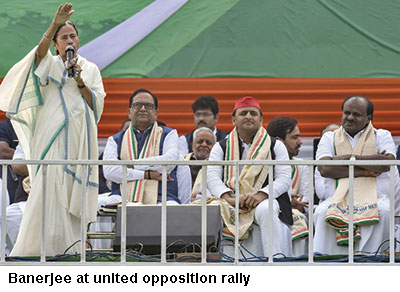 With general election 2019 just a few months away, in a major show of strength Trinamool Congress (TMC) supremo and West Bengal chief minister Mamata Banerjee convened a massive ‘united opposition rally’ in Kolkata on January 19 to highlight the “misrule” of the Bharatiya Janata Party which is in office at the Centre and 16 states countrywide.
With general election 2019 just a few months away, in a major show of strength Trinamool Congress (TMC) supremo and West Bengal chief minister Mamata Banerjee convened a massive ‘united opposition rally’ in Kolkata on January 19 to highlight the “misrule” of the Bharatiya Janata Party which is in office at the Centre and 16 states countrywide.
Against the backdrop of the BJP suffering major defeats in recent state assembly elections in the Hindi heartland states of Rajasthan, Madhya Pradesh and Chhattisgarh, Banerjee is making a determined bid to unite the country’s major national and regional political parties against the BJP which won General Election 2014 hands down, with an absolute majority in the Lok Sabha followed by a thumping win in several states including Maharashtra. However, West Bengal was an exception. In the West Bengal assembly election of 2016, the TMC was returned to office in Writers Building, Kolkata with a massive majority of 211 in the assembly. Consequently, Banerjee has emerged as a formidable leader in the proposed mahagathbandhan (grand alliance) taking shape to take on the BJP juggernaut in General Election 2019.
Opposition party stalwarts who attended the ‘united opposition rally’ are only too aware that the BJP swept General Election 2014 with a mere 31 percent of the popular vote, because the majority vote against BJP candidates in every constituency was divided between opposition party candidates. Now the thinking is that if the opposition parties agree on fielding only one candidate in each constituency, the BJP can be ousted from power in New Delhi. And if TMC can sweep all the 42 Lok Sabha constituencies of West Bengal — or at least 35 — Banerjee could emerge as a consensus prime ministerial candidate of the opposition.
But to achieve this feat in General Election 2019, Banerjee needs to placate and win over West Bengal’s middle class, particularly its bhadralok (refined middle class) which has been less than impressed by the failure of TMC to reform and rejuvenate the state’s education system ruined by steady infiltration of ill-educated CPM apparatchiks during the CPM-led Left Front government’s 34 years of uninterrupted rule. The dominant sentiment within the bhadralok and intelligentsia is that instead of implementing root and branch reform and cleansing the Augean stables of the state’s education system, TMC has preferred to replicate the strong- arm tactics of the CPM by letting the Trinamool Chhatra Parishad (student wing of the TMC) run amok in education and the academy.
But with this strategy proving ineffective and unpopular with the middle class, during the past 12 months the TMC government has taken several steps to shake up the education sector. They include measures ensuring the regular attendance of teachers in the state’s 92,000 government schools and inaugurating 65 English-medium government primaries in the districts of Kolkata, North 24 Parganas, Nadia and Jalpaiguri. Moreover, during the past seven years the state government has promoted ten green-field private and 12 public universities, raising the number of varsities in the state from a mere 12 to 34, plus 50 new colleges.
Yet perhaps the best news for West Bengal’s hitherto abused and/or neglected higher eduation system is that an All India Institute of Medical Sciences (AIIMS) is taking shape at Kalyani, Kolkata, modelled on AIIMS Delhi, routinely voted India’s #1 medical college-cum-hospital. AIIMS, Kalyani will admit its first batch of 50 MBBS students this year. Given that West Bengal (pop. 91 million) hosts only 17 medical colleges, of which 13 are promoted and managed by the state government, news of AIIMS, Kalyani, 50 km from Kolkata, has been widely welcomed by academics and the medical fraternity statewide. According to education ministry sources, 60-70 percent construction work to accommodate first year students has been completed in this mega project being constructed on a 180-acre campus at an estimated cost of Rs.1,754 crore.
Unsurprisingly, medical practitioners and professionals are excited about the AIIMS project and entertain the hope that it will transform Kalyani into an education hub on the lines of Vellore in Tamil Nadu. “Private hospitals don’t cater to the general public. Therefore the high-quality medical care offered by the new AIIMS will be a huge benefit for students and the lay public,” says Dr. Suvro Banerjee, senior consultant and interventional cardiologist at the Apollo Gleneagles Heart Institute, Kolkata.
Even if belatedly, West Bengal’s moribund education system is getting a makeover during the second term of TMC and Banerjee. And the chances of didi (sister) emerging as a national leader of substance after General Election 2019, now less than 100 days away, are improving day by day.
Baishali Mukherjee (Kolkata)

























